The history of the Chapel, as provided in this document, is the result of evidence deduced from documentary research, interviews with numerous parties, and photographs made available from various sources. The Chapel’s conceptual design and construction, was influenced by the need that was realised, and shaped by the people who ministered to the needs of the community living on the Raap Kraal farm, the Raap Kraal area, and the freehold land of Weltevreden. The history depicts the personalities that shaped the history of the Chapel and how the ministry, through the Chapel, impacted all who would come to worship.
It is important to note that the people who were involved in the various activities at the Chapel came from various backgrounds. Some were rich, others seemed to be living relatively comfortable whilst others were poor. Roger Voke (1994) described the people to whom Herbert Alfred Voke would minister as a “so-called Coloured community” (1994: 13) who inhabited, what he described as “corrugated iron shanties” (Ibid.) in a “depressed, squatter area called Raap Kraal” (Ibid.). This poverty stricken area, the children living on the Raap Kraal farm and the surrounding areas, were the focus of the Sunday School work that formed the need for the construction of the Chapel.
In this document the names Raap Kraal, Raape Kraal, and RaapKraal are all used as they are contained in the various documents that were consulted. It is therefore important to note that they are typing or spelling errors, but rather that the various names were utilised during different periods of the area’s history.
The Lord’s work through the chapel
The Genesis
During the 19th century the area that today is known as Lakeside consisted of farms, and other types of properties. Amongst these farms was one called “Raape Kraal”, near Muizenberg, that was broken up into various lots that were sold off to various owners, and the remainder of the land on the “Raape Kraal” farm was Freehold land known as Weltevreden. One of the lot owners was a certain Hendrik Andries Bruyns who owned Lot A portion of the divided Raape Kraal farm. On 24 July 1895 Hendrik Andries Bruyns sold Lot A to Isaac Kenderdine Beardmore who went on to hold the title deeds until 22 November 1932.
During this time David Frederick Hendrikse, a land proprietor and farmer, and his family were residing in the Retreat area. Between 1894 and 1923 he acquired several properties of which the farm “Raape Kraal” was one of them. This farm, which was purchased on 29 Mar 1917, served as the family residence from which Katie Maria Hendrikse, born 19 November 1890, and Emma Jessie Hendrikse, born 27 October 1899, began pioneering the Sunday School work during 2018/19. Farms were manpower intensive and most of those who laboured on the farms also lived on the farms with their families. The farm dwellers had many needs amongst which were spiritual needs. These spiritual needs were identified by Katie and Emma Hendrikse, who then began the Sunday School that was held at the Manor House in Niblick Street, in Lakeside.
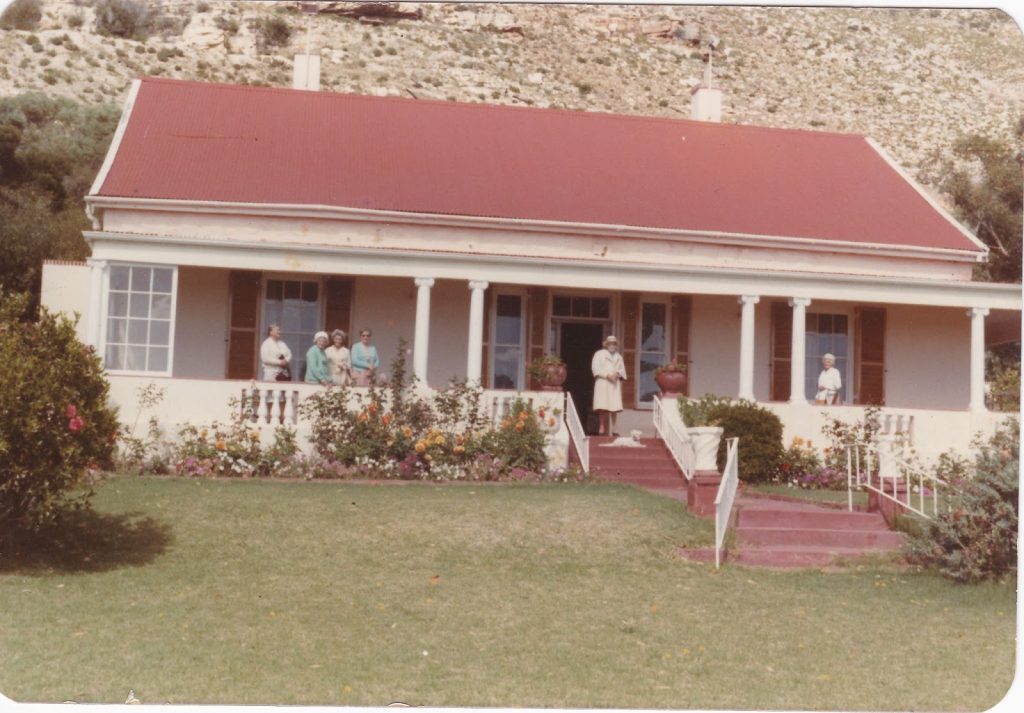
The Sunday School work flourished and comprised children that lived in appalling conditions on the Raap Kraal farm, the Raap Kraal area, and the adjacent areas. The number of children attending the Sunday School soon outgrew the available space at the Manor House. The photograph provides evidence of the cosmopolitan composition of the Lakeside Sunday School in 1920. From the description on the photograph it could be argued that the Sunday School was an entity of the area that would later be attached to the Christian Brethren Church. An alternate venue for the Sunday School was needed to accommodate the growing number of children attending the Sunday School and it was decided, with Mr Isaac Beardmore’s permission, to build a Chapel on a portion of Lot A that belonged to him. From this it can be deduced that Isaac Beardmore was a fellow believer, possibly a member of the Christian Brethren Church, or someone who had a passion for the children hearing the good news of the Lord Jesus Christ. It is most likely that Isaac Beardmore was a member of the company of Christian Brethren to whom Herbert Alfred Voke and Fred Elliot came to minister during their visit in 1921.
During 1922 the Chapel, which became the home of the Sunday School under the leadership of Katie and Emma Hendrikse, was erected. The finance for the construction of the Chapel was provided by their father and the building was completed during 1922. The photograph below provides an indication of the number of adults and children that were present when the Chapel was opened in 1922. The congregation, or as the Brethren Church proscribed, the assembly was cosmopolitan in its composition.
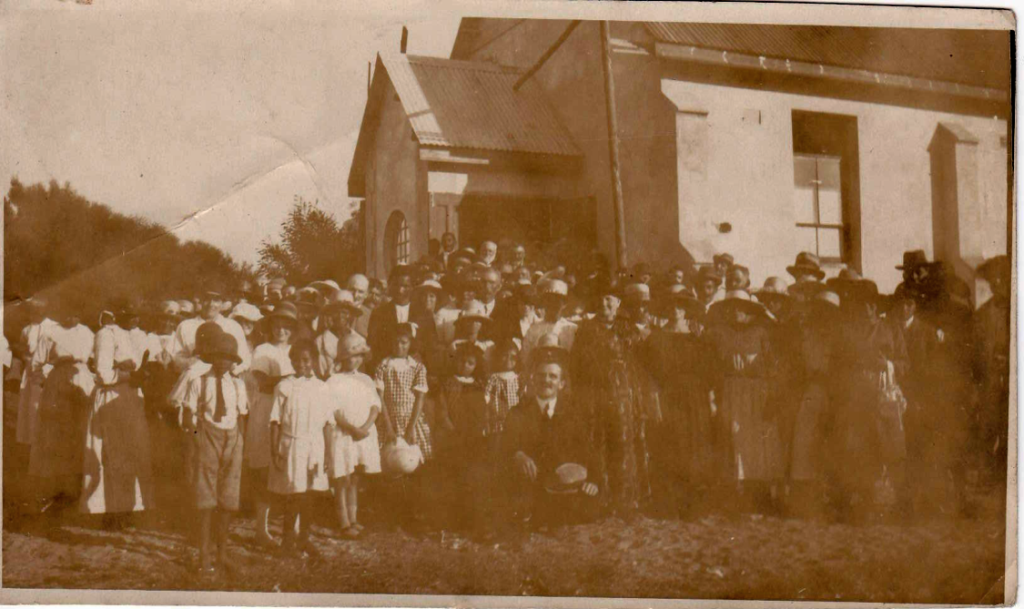
Herbert Alfred Voke
Herbert Alfred Voke was born in Britain on 18 November 1884. As a young teenager he committed his life to the Lord. His education was short-lived as he was compelled to work at a young age after his father passed away. Roger Voke’s book indicated that Alfred Voke was a remarkable person who memorized large portions of the Bible, studied Greek, read widely, and learned to speak some European languages which he spoke fluently. He also learned to play musical instruments such as the piano, organ, harmonica, Jewish Harp and the violon. In 1905 he married Elizabeth Ada and from this marriage four children were born. In 1919 Elizabeth died and in 1921 Herbert Voke visited South Africa with Fred Elliot. Herbert Voke’s unflinching commitment to God was so compelling that he left his four children in the care of faithful friends. Fred Elliot would become a much loved and world travelled evangelist. Whilst his visit was aimed at ministering to a company of Christian Brethren Herbert Voke possibly came into contact with Isaac Beardmore, and the Hendrikse family where he witnessed the Sunday School work that was pioneered by Katie and Emma Hendrikse amongst the children on the Raap Kraal Farm and surrounding area.
Herbert Voke, after returning to Britain, felt the Lord’s calling to spend the rest of his life in South Africa doing Gospel work. After his return he met Hilda Ruffels whom he married on 3 May 1924. Hilda Ruffels was a trained nurse who was skilled in general nursing, midwifery, fever, mental, children’s nursing and would prove to be God’s providence as she performed a medical ministry amongst the people living in the Raap Kraal area.
Soon after his marriage Herbert, Hilda and two of his children set sail to South Africa where he, with the kind assistance of the Hendrikse family settled in Retreat form where he ministered at the Gospel Hall in Lakeside. He went on to become an Elder and fulfilled many functions and was instrumental in weaving the evangelical fabric of the Christian Brethren Church in Lakeside. He was a preacher, teacher, marriage officer, and counsellor, amongst the many functions that a leader of a Church would fulfil. As an elder he would have accepted the responsibility of training young men to minister the word of God. Amongst those young men was Ernest de Vries who would later become an elder and Sunday School Superintendent. He was also involved with the training of his own son, Roger Voke. It was their prayer, as parents, that Roger would continue the work of his father. This prayer would be answered as Roger would go on to be used by the Lord greatly in reaching many with the Gospel as a minister.
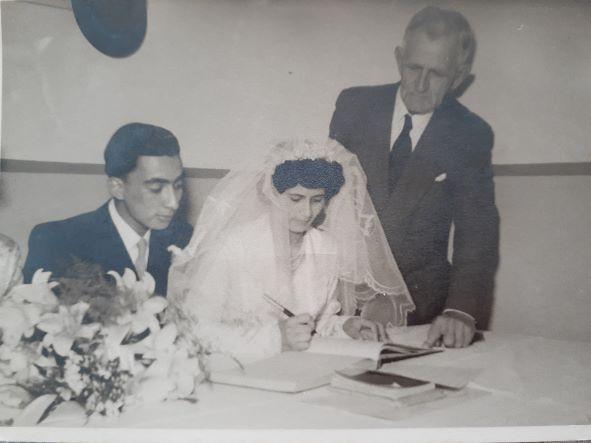
The chapel’s new ownership
After the death of David Hendrikse in 1924, and his wife Catherine in 1931, the farm Raape Kraal was bequeathed to their son Henry Stephen Hendrikse, a dairy farmer. The history of West Lake Golf Course indicated that the owner of the Raap Kraal Farm was a dairy farmer named Mr Hendricks. However, a document containing the results of an assessment completed by the UCT Archeological Society indicates that the property was owned by Henry Stephen Hendrikse, who inherited the farm Raape Kraal from his parents. They also left farms to their other sons Arthur and William. On 22 November 1932, Mr I.K. Beardmore and the Hendrikse family agreed to sub-divide Lot A creating Lot G.H.L. which was the portion of land on which the Chapel was built. William Hendrikse, the brother of Katie and Emma Hendrikse, bought Lot G.H.L. placing the Chapel in the hands of the Hendrikse family for the sisters to continue their ministry. This acquisition most likely gave Katie and Emma the freedom to do so.
On 31 August 1945, Katie and Emma Hendrikse purchased Lot G.H.L. from their brother William Hendrikse, which gave them full control over the property. The property was re-named ERF 84813 as it is currently known. On securing the title deed, Katie and Emma donated ERF 84813 and the Gospel Hall to the Christian Brethren Company. With the responsibility of the Gospel Hall on the shoulders of the Christian Brethren Company, the sisters could once again focus their full attention on the Sunday School. According to Mrs Ruth de Vries, Katie Hendrikse would actively go into the streets to encourage parents to send their children to Sunday School.
Ernest de Vries the young elder
On 19 July 1930, Ernest de Vries was born in Lakeside, in the establishment known today as the “Toad on the Road” that was then the family residence. At the age sixteen, whilst at the Methodist Church, he committed his life to the Lord and came over to the Lakeside Assembly of the Christian Brethren Church where he grew as a believer. During this period, he found the Hendrikse sisters, Mrs Aletta Daries, and her daughter, Ruth, teaching Sunday School. As he grew in his relationship and walked with the Lord, under the guidance of Elder Herbert Voke, he began to accept greater ministry responsibilities . He was then entrusted with the responsibility of ministering to the youth by presenting “Lantern Services” on Friday nights. Ruth de Vries would operate the Lantern while Ernest de Vries would comment, preach or teach in relation to the images that were projected. This testified of the team effort required to make the Lantern Services successful. According to Mrs Ruth de Vries, these Lantern services were popular and well attended. Ernest de Vries made a massive contribution to the evangelical fabric that was being developed at the Lakeside Assembly. The success of his ministry resulted in him, at the age of thirty years, being appointed as an elder, youth ministry, and Sunday Superintendent encouraging him to continue his excellent ministry and leadership. On his journey to becoming an elder, he married Ms Ruth Daries, one of the Sunday School teachers that taught with Katie and Emma Hendrikse.
The Beute Family
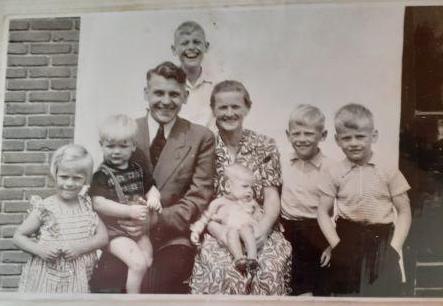
The Beute family arrived in South Africa from Holland on the passenger liner De Waterman in December 1953, residing in Bellville for six (6) months before settling in Muizenberg in 1954. Jan Beute, on arrival, sought the local Brethren Church congregations and found the Gospel Hall in Lakeside. The Christian Brethren Assembly in Lakeside were aligned with the doctrines of the Plymouth Brethren Church, to which the Beute family also subscribed. The Plymouth Brethren Church came into existence to move away from the Episcopalian hierarchical system that focused its attention upon church government rather than focus on the Gospel. The Plymouth Brethren or Assemblies of Brethren, asserted that the Bible was over and above any other source of authority as the supreme authority for church doctrine and practice. This was the practice of the Gospel Brethren Church at the Lakeside Assembly.
The Beute family found that the Lakeside Assembly offered a Breaking of Bread Worship service on a Sunday morning, the Sunday School on the Sunday afternoon and their Gospel services were held in the evening. Jaap Beute, the son of Jan, explained that the Chapel was known as the Gospel Hall because the Brethren Church believed they needed to spread the Gospel and the Beute family found the Gospel Hall being utilized for that very purpose. Based on the Gospel being preached and taught the Lakeside Christian Brethren Assembly emphasized God’s love for all mankind Jan Beute and his family joined the assembly for worship. The Beute family settled in Muizenberg and very soon made great strides and contributions in the life of the CBC.
An undesirable exodus
In 1948 the National Party came into political power based on the ideology called “apartheid. This policy of apartheid demanded that people were to be separated along racial lines and assigning separate residential areas and busienss areas. John Laband’s book, “The Land Wars” very briefly describes the negative effects that the three Group Areas Acts viz: Act no 41/1950; Act no 77/1957 and Act no 36/1966 had on the racial groups that inhabited the Cape Province. Whilst the physical separation of the people was only implemented much later, the effects were felt almost immediately. The racial groups were forcefully removed after Act no 36/1966 was published in the Government Gazette. The Christian Brethren Church had worked hard to wave an evangelical fabric based on God’s love for the fallen human race, but now faced a dilemma of obeying God’s injunction of loving all His people or obeying the new government’s law of separation. The ministering of the Gospel nevertheless continued until the publication of the group areas act, which meant that only the white race was allowed to worship at the Gospel Hall at Lakeside.
The congregation and Sunday School was previously cosmopolitan in its composition and its size was reported to be adequate for self-sustaining. This cosmopolitan make up was one that evolved naturally, and the implementation of the State’s apartheid policy would have severe negative affects on the entire congregation. Those from other race groups would be forced to sever ties with their fellow believers who would remain at the Lakeside Assembly Gospel Hall. A dividing line in the sand had been drawn. The separation of the believers at the Lakeside Assembly of the Brethren Church caused an irreparable tear in the Assembly’s evangelical fabric.
The Gospel continues
Despite the tear in the evangelical fabric of the Gospel Brethren Church, the ministering of the gospel continued at the Gospel Hall. It was very clear that God’s law of love, as contained in the supreme authority of the Bible, and as held by the leadership and membership of the Lakeside Assembly, prior to the publication of the group areas act in 1966, took an inferior position in relation to the law of the land. Jaap Beute explained that interim arrangements were made whilst the Gospel Hall in Steenberg was being constructed. He remembers attending Sunday School at the Manor House in Niblick Street whilst the other children, who were the overwhelming majority, attended Sunday School at the Gospel Hall. With the ministry of the gospel continuing with the reduced membership from the Gospel Hall at Lakeside, a decision was made to improve the appearance of the Gospel Hall and a few projects were undertaken and completed. The CBC had already, previously, added at the front (the east street entrance with ablutions), as also the social hall built at the back. Much previous, the square windows were replaced and arched to make the Gospel Hall look more like a Chapel. Some frowned upon the modernization effort claiming it was too church-like especially after the conservative Brethren fought hard not to identify with English ‘Episcopal order and form.
The Gospel Hall Assembly, in its ministry, served as a spiritual home for missionaries who ministered in the area. Mr and Mrs Lohr, who were medical missionaries, came from Chingola, Zambia, joined the Assembly as the place where they could break bread with the fellow believers. They arrived during the late 1950s and early 1960s to manage the Christian Towers Guest House, which is the beautiful large and wide stone building, situated up and behind the Muizenberg Methodist Church. Mr Lohr was Trevor Glaum’s grandfather. Trevor Glaum was a long standing and faithful member of the Mountain View Baptist Church. Mr Lohr and Jan Beute served as Elders in the Lakeside Assembly during the 1960s. Katie and Emma Hendrikse remained active in the Assembly teaching Sunday School and hosted several missionaries, in the Manor House, who came on furlough from the Congo. The Manor House was used for other aspects of ministry such as weddings, prayer meetings, and other ministry opportunities.
As the years passed, the membership and attendance of the various worship services never seemed to recover. During the 1980s and into 1990s the attendance was not good, and the membership dwindled to such a degree that the Sunday evening Gospel services gradually came to a halt. This was a tragedy as the Assembly was unable to create an interest and attract more people to attend the breaking of bread and Gospel services. The Sunday School was almost non-existent, and the Chapel/Gospel Hall needed new life.
A new era on the horizon for the chapel
Lakeside Baptist Church (LBC)
Meanwhile, during the 1970s and 1980s, members of the Meadowridge Baptist Church (MBC) living in the Lakeside area and former students at the Bible Institute of SA (BISA), being seriously affected by the rising fuel costs, organized themselves into a lift club. In addition to assisting to reduce the traveling costs MBC initiated Sunday evening Church services in homes in Lakeside that commenced in February 1979. These house services facilitated the participation of entire families and enabled participants to enjoy a light meal after the service.
Early in 1980 a Sunday School was established at the Muizenberg Junior School (MJS). At the same time Vernon Light, a theological graduate, was commissioned under the authority of the MBC to assist the work in Lakeside. The house service attendance grew to such an extent that by the end of 1980 the house was too small to accommodate the Fellowship, and the services in the MJS foyer commenced simultaneously with the Sunday School.
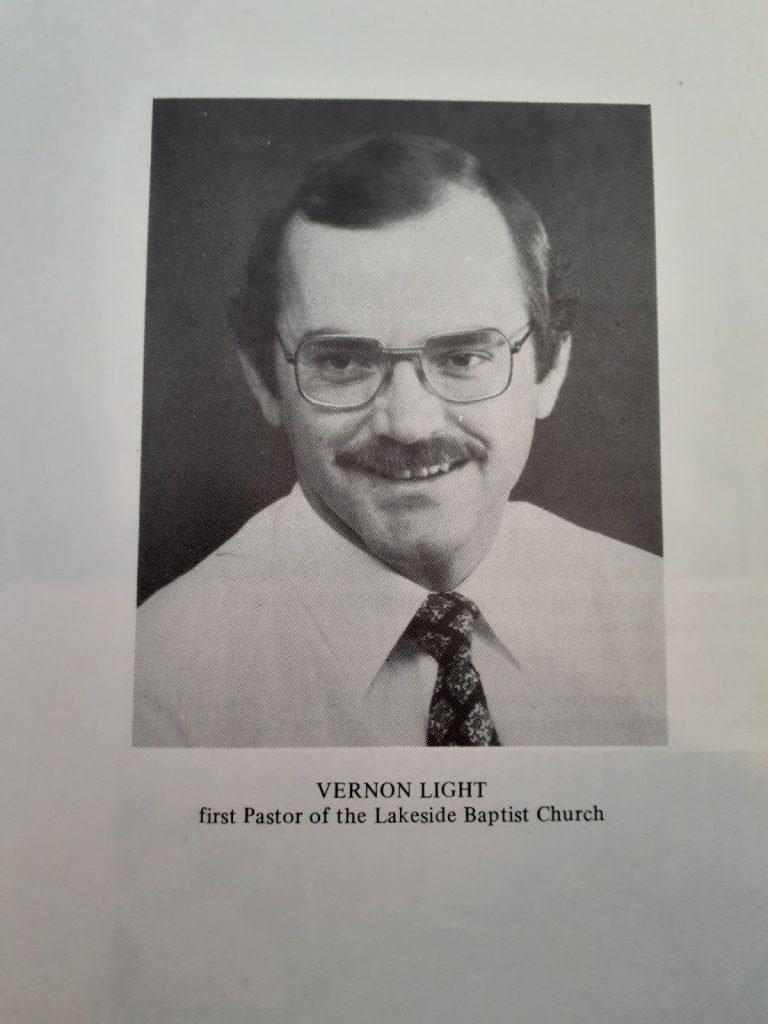
During 1981, Vernon and Heather Light committed themselves full-time to work at the Lakeside Fellowship and in February they led the morning service that was started in the MJS foyer. At the same time, due to the growth, it was decided to run two Sunday evening house services to provide more ministry opportunities. These ministry opportunities highlighted a need for leadership training. To facilitate personal development, leadership training, and discipleship, the mid-week Bible study group was split into smaller groups.
During 1981 and 1982 some families transferred out of the area and as a result the Sunday evening house services, as well as the mid-week Bible study groups were consolidated. By late 1982 the development of the preaching ministry and the leadership training began to show positive results as the attendees at the Sunday morning service filled the school foyer. The LBF grew to the extent that the school foyer was no longer big enough so they began to use the MJS library and later the main school hall was being utilized. By 06 March 1983 the Fellowship had grown sufficiently to constitute an autonomous Church named the Lakeside Baptist Church. Not long thereafter Rev Vernon Light was called to a Church in Gauteng and the LBC called Rev Jim Harris as his successor. Allan and Lynda Hewitt, Brian and Margaret Knipe, and Daphne Du Preez, who are still members of the current MVBC, were among the constituting members of the LBF.
The Mountain View Baptist Church (MVBC)
The Mountain View Baptist Fellowship (MVBF) was constituted as an extension of the Meadowridge Baptist Church in November 1989 as part of their 25th Anniversary celebrations, in the Kirstenhof/Tokai area. According to the draft constitution a steering committee was to be elected annually until the fellowship became an autonomous Church with the first elections scheduled to take place in November 1989. The first MVBC Steering meeting, comprising Rev. John Adams, Colin Lee, Henry Puren, Roy Mayers, Godfrey Myers Alan Day, and Brian Musto, was held at 2 Crane Close, Tokai, on 9 November 1989. Rev. Adams chaired the meeting during which Brian Musto was appointed secretary and Colin Lee was appointed treasurer.
Four possible venues were being considered for Church Services viz: a hall at Westlake, Old Zwaanswyk School building, Kirstenhof Primary School (KPS), and a hall at Pollsmoor Prison. During the MVBF Steering Committee meeting, held on 25 January 1990, it was reported that the Old Zwaanswyk School building would be used for Church services as an interim measure. The first baptismal service took place at Meadowridge Baptist Church on 29 April 1990.
On 17 January 1990 Rev John Adams, on behalf of MVBF, submitted a written application for membership of the Western Province Baptist Association. The application revealed the names of fifty-five persons. The MVBF was led by a Steering Committee that was responsible for providing leadership for their members. The Steering Committee made decisions about the meeting places for Sunday Services, Sunday School, Youth group meetings, etc.
At the MVBF Steering Committee meeting held on 26 April 1990 the Rev John Adams advised that the MVBF had obtained Observer status with the WPBA. The Fellowship continued to grow and on 21 April 1991 constituted the Mountain View Baptist Church (MVBC). As the Church grew numerically a suitable place of worship became a priority. The members of the MVBC considered purchasing the Comfy Carrier building in Constantia, or a building in Raapkraal Road, Kirstenhof. The owner of the Comfy Carrier building declined to sell and the building in Raapkraal Road did not meet the Church’s requirements. During 1992 the MVBC membership also began to dwindle.
In 1993 the LBC and MVBC held a joint service which would have been the basis that led to the later amalgamation of the two Churches. On 28 April 1993 the MVBC and LBC were constituted as the MVBC and held their worship services at the KPS. Shortly after constituting as the MVBC, the Chapel was hired from the Brethren Church for worship services. According to Jaap Beute, then still a member of the CBC, the MVBC was offered the use of the Chapel for evening services instead of hiring the KPS hall for the purpose. In 1997 MVBC purchased the Chapel from the Christian Brethren Company and did much needed renovations. Not long after the purchase of the Chapel Rev John Adams withdrew from MVBC to return home to the UK and the Church was led by the elders Chris Reid, Glen Stavrides and Trevor Owen.
MVBC had been without a Senior Pastor for 3 years but was a very active congregation and felt that they needed someone to continue and consolidate the work. The Church called a young 27 year old Rev Kevin Daines and his wife Michelle to start in January 2001. The Church held Sunday Morning and evening servcies, a number of midweek Bible studies, weekly junior and Senior Friday night youth groups as well as annual camps for the younger and older groups.
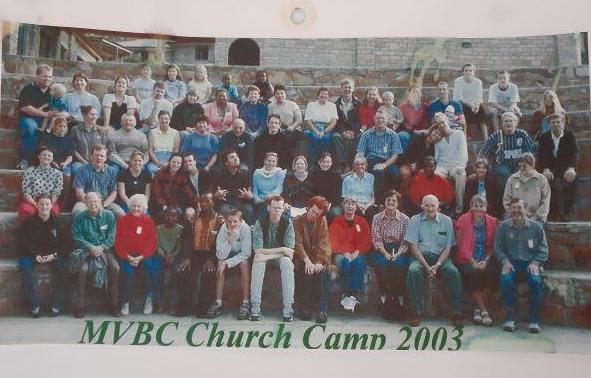
There was also an 050 pensioner outreach lunch to Seniors citizens in the area that had to be limited to 50 people or more would have come that there was no space for. They would be offered a 3 course meal, sing worship songs and receive a Gospel message. The church itself had annual camps to Rocklands in Simons Town that served as a great time of refreshing fellowship and building up in God’s Word. Weddings and funerals were conducted when needed for the congregation or members of the surrounding community. The Easter Sunrise servcie (or ”Sonrise” service as it is called) has been one of the church highlghts each year as she worked with other churches in the area to host this service in the open at the Zandvlei Yacht Club.
There was also a monthly chapel service to the elderly people of Mez Wallach. The church was also a trustee and played an important role in the formation and establishment of the Westlake United Church Trust that still serves the Westlake community today with many social upliftment projects including a Pre-primary school, adult based education, a health clinic with Home based care and a community advice service centre, just to mention some of the work that has and is still being done in Westlake. This seemed appropriate when one remembers that the church had always been involved in outreach to the less fortunate in the area since it’s beginning.
With the ever increasing population size in the area and the rising height of walls and fences around properties, the need to reach out to the neighbours was made difficult and innovative ways had to thought of to do so. Generally speaking, people did no longer naturally seek out churches for help and guidance. The church had created a position of Care Co-ordinator that was fulfilled by Judy Strickland and involved counselling. Out of this the vision grew to start a counselling centre that would be run by Judy and her husband Allen. It would offer free counselling to the community on a donation basis from the church office. The facility was called Hope House Counselling Centre and the need for such a place was immediately felt with many people coming for couselling. After a number of years they would out to bigger premises but the work has continued.
Further abroad, MVBC has supported various missionaries in some faraway places such as the Tetteh’s in Ghana and the Beadles in Central Asia. On occasion, the church body itself has gone on short term mission trips to more regional places within South Africa such as Pomfret, Rooiwal and more recently Karatara with Dylan & Nikki Groep.
Locally, the church has had a good working relationship with the Bible colleges of George Whitefield College, The Bible Institute and the Baptist Seminary, being in a position to support, care and develop students as well as benefitting from their involvement in the life of the church. The need to share the good news Gospel of Jesus Christ has always run in the veins of the church. She has also been gifted with a caring spirit as can be seen by the various relief ministries that operate from the church and that exists among the kind and generous members of the church. The visible location of chapel on Main road makes it ideally situated to be seen and known by all in the area.
With the Chapel being an old building, much time has to be spent with her upkeep and maintenance. Thankfully there has always been a good number of willing men who are able to do such work to keep the costs down. As the activity at the church translated into growth, the chapel became unable to cope with the needs and numbers of children and adults attending the church. A decision was made to purchase a neighbouring house that came up for sale at 24 Service road. This allowed the church to move a large wooden Cabin in the Chapel yard that was used for Sunday School, across to the new premises. It also created facility for much needed offices, counselling and meeting rooms, a youth hall and more Sunday School rooms as well as a garden for a play area for children, Many social gatherings such a braais and birthday functions have also taken place at 24 Service that came to be referred to as the Church office. As the church grew, so did the staff compliment and the office allowed space for this to take place.
Project Solomon
Further growth in the number of people attending services, resulted in the church opening a second morning service, one at 8am in addition to the existing 930am and evening service. This put pressure on those involved in the running of these services and also resulted in two separate congregations forming. It was not an ideal situation and so after much prayerful thought, the plan was put in place to address the general shortage of seating space in the Chapel and the issue of insufficient space for parents with young children that were attending. Often families with young children would leave the church because there was not enough room for them in the small room that was available. The building projects would be known as Project Solomon. It was the insight and skills of people such as Jaap Beute and Brian Knipe that enabled the church to design and build a first storey gallery and cry room within the existing Chapel. This provided more seating, additional toilets and a much better and larger area for parents and their children while still being able to be part of church services.
A new section was also built for a kitchen that then allowed the old kitchen area behind the stage to be used as a stage and for a new north wing to be added onto the existing Chapel area. It was quite an undertaking to convince local government authorities and historical societies to agree and allow this work to be done but eventually they did give their approval. What was also significant in this project is that there was a global recession during this time and yet every resource that was needed came in as the Lord put it on people’s hearts to give. In a time of famine, the church had plenty (Psalm 37:19).
With the gallery and these new additions, the seating space was doubled from 100 to 200 seats. Other work later took place at the church office (The Nehemiah Porject- to repair the ruins) again with the help of Jaap, Brian and Allan Hewitt. They replaced an existing run down garage into a much larger youth hall for the youth and children to meet in. In all of these projects, it could be seen how the Lord provided all the necessary resources to do so. The congregation was at no point an affluent community that further demonstrated the Lord’s provision in it all. As skills or money was needed it became available for the work to go on without disruption.
Conclusion
With so much activity since 1993, 29 years of MVBC’ ministry, and that of those who preceded this time, one must recognise the many sacrifices people have made over the years to make this all possible. Those people giving of their time and resources, many whose names have not even been mentioned here but whom God knows and has seen what they have done in service to Him. Most importantly, it is the Lord who has proven Himself faithful! He has been faithful to His missional purpose in ensuring a witness to reach the lost with the good news Gospel of Jesus Christ through the Church’s presence in Lakeside. He has been faithful to His people, to the church congregations who have met in the Lakeside Chapel for 100 years. He has shown Himself as faithful by providing for the many needs that have arisen among His people over that time, both spiritual and physical. He has been faithful through the many difficult times the church has faced, to see her through them all and make her stronger for it. It is the stories of those people that are hardest to capture in an article like this, people’s whose lives have been touched and changed for good by the Lord through His people- the Church. May the Church in Lakeside continue to experience the Lord in however many years it takes before His final return.
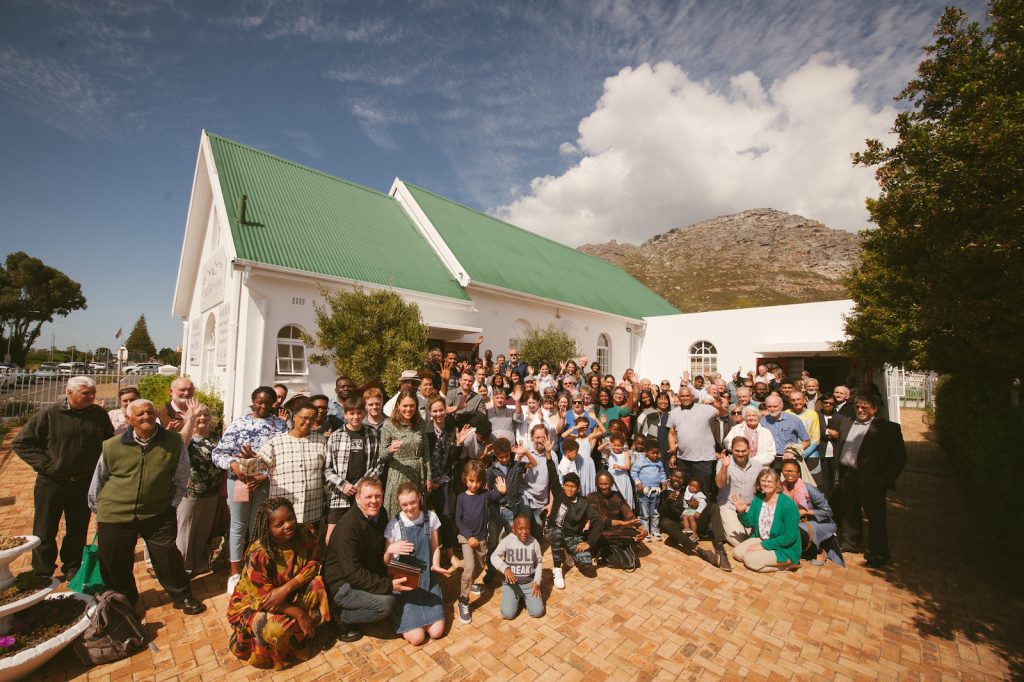
But you are a chosen people, a royal priesthood, a holy nation, God’s special possession, that you may declare the praises of him who called you out of darkness into his wonderful light. Once you were not a people, but now you are the people of God; once you had not received mercy, but now you have received mercy.
1 Peter 2:9–10